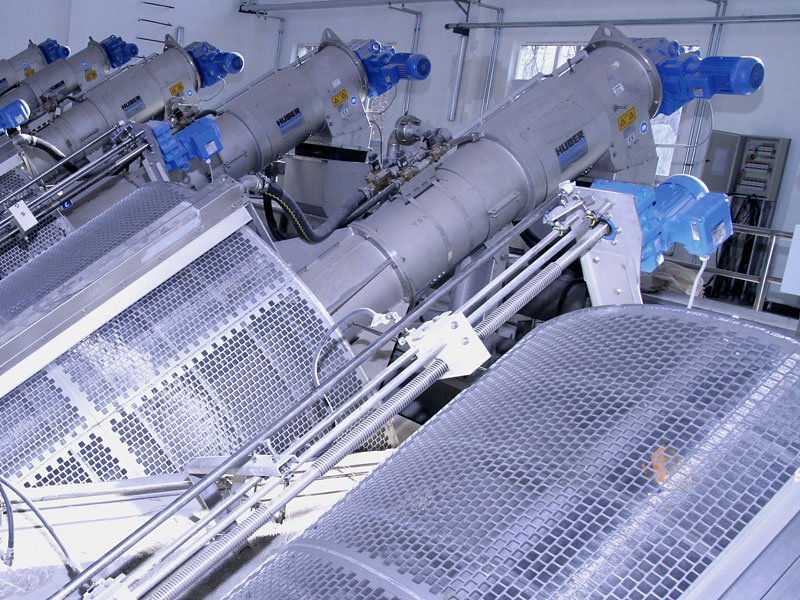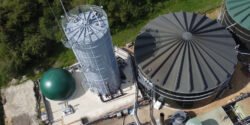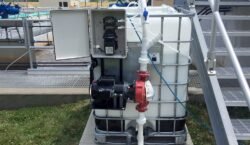Microscreens in Wastewater Treatment: Enhancing Filtration Efficiency

Microscreens are an essential component in modern wastewater treatment processes, designed to remove fine particles from effluent streams. They operate by filtering water through screens with very small openings, which are capable of capturing particles that are often missed by larger screening systems. Due to their fine level of filtration, micro screens play a crucial role in the advanced treatment stages, ensuring that the water released into the environment minimally impacts the aquatic ecosystem.
The engineering behind micro screens involves a combination of mechanical and biological principles. With design specifications that consider factors such as flow rate, screen opening size, and the nature of the particulate matter, these systems can be optimized for various types of wastewater. They require careful operation and maintenance to keep them functioning effectively, often employing automated cleaning mechanisms to prevent clogging and maintain consistent performance. By stringently monitoring performance metrics, wastewater treatment plants can ensure compliance with environmental regulations and standards.
Key Takeaways
- Microscreens are vital for removing fine particles in wastewater treatment.
- Their design and operation require meticulous attention to detail.
- Effective micro screening helps meet regulatory standards and reduce environmental impact.
Fundamentals of Microscreens
Microscreens are advanced filtration technologies crucial for removing fine particles from wastewater. This section delves into their basic principles, types, and role in treatment processes.
Definition and Function
Microscreens, consisting of fine mesh materials, serve to capture particulate matter from wastewater streams. Functioning as a physical barrier, they are pivotal in the preliminary stages of wastewater treatment, where they effectively reduce turbidity and protect downstream processes from excessive loading.
Types and Characteristics
Various types of micro screens cater to different requirements of wastewater treatment:
- Rotary Drum Screens: Characterized by a rotating cylindrical drum covered in a microscreen mesh.
- Static Screens: Non-moving screens that rely on gravity for filtration.
- Belt Screens: Comprising a moving belt of micro-fabric that filters as it circulates.
Each type boasts unique characteristics such as mesh size, which typically ranges from 10 to 60 micrometers, and flow capacity, determining their suitability for specific treatment applications.
Role in Wastewater Treatment
Embedding microscreens into wastewater treatment processes improves effluent quality by removing algae, small debris, and other suspended solids. They play a critical role as a pretreatment step, not just safeguarding the integrity of subsequent treatment stages, but also enhancing the overall efficiency of the wastewater treatment facility.
Design and Engineering
The section outlines the intricacies of micro screen wastewater technology, emphasizing the careful consideration required in design, material choice, and addressing engineering hurdles.
Micro screen Technology Design
Microscreen systems consist of a fine screen material that captures suspended solids from flowing wastewater. The design typically includes a rotating drum or a panel that allows water to pass while retaining solids. Factors like flow rate, screen mesh size, and the quality of effluent determine the specific design parameters. It’s critical to match the screen size to the anticipated particulate sizes to optimize filtration efficiency.
Material Selection
For micro screens to function effectively, the selection of materials is crucial. Components are often made from stainless steel for durability and resistance to corrosion. The screen mesh, pivotal in determining the system’s effectiveness, is commonly composed of woven stainless steel or synthetic fibers. The material must be robust enough to withstand the mechanical stress of rotating mechanisms and the chemical nature of the wastewater.
Engineering Challenges
The engineering of micro screens entails overcoming several challenges:
- Clogging: A primary issue is the potential for screens to become clogged, which reduces treatment efficiency and requires frequent maintenance.
- Wear and Tear: Physical wear from constant use demands materials with high endurance.
- Space Constraints: Engineers must often design systems that fit within limited spatial footprints without compromising performance.
Systems are engineered to include automated cleaning mechanisms to manage clogging, and ongoing research focuses on innovative materials that proffer extended lifespans despite the harsh operating conditions.
Micro screen Operation
Microscreen systems are utilized in wastewater treatment to remove fine solids through a physical filtration process. They work efficiently when installed correctly, operated within the designed parameters, and maintained regularly.
Installation Procedures
Proper installation of micro screens is crucial for optimal performance. It begins with the careful selection of a site that accommodates the system’s size and access for future maintenance. The manufacturer’s guidelines should be followed meticulously, ensuring that all components, such as the screen drum, internal nozzles, and conveyance systems, are aligned and secured. This may involve:
- Establishing a level base for the micro screen unit
- Connecting inlet and outlet pipes with appropriate seals
- Installing the drive mechanism and power supply according to specifications
- Verifying that control panels are accessible and protected from environmental factors
Operational Parameters
Once installed, operating the micro screens within specific parameters guarantees their effectiveness. Essential parameters include:
- Flow Rate: Adjusting the influent flow to match the screen’s design capacity
- Screen Size: Utilizing the correct screen aperture size for the intended solid separation
- Differential Speed: Regulating the rotational speed for optimal shear and cleaning forces
- Backwash Cycles: Programming the frequency and duration of backwash cycles to prevent screen blinding
Maintaining a balance between these factors is critical to reduce wear and tear and maintain filtration quality.
Maintenance and Cleaning
Routine maintenance and cleaning are imperative to prolong the life of the microscope and ensure continuous operation. Key maintenance tasks include:
- Inspection Schedule: Conducting regular inspections of the screen, seals, and bearings
- Cleaning Regime: Implementing effective cleaning procedures to remove accumulated solids and biofilms
- Lubrication: Ensuring moving parts are lubricated according to the manufacturer’s recommendations
- Wear and Tear: Replacing worn components such as seals and nozzles to prevent breakdowns
Documenting all maintenance activities helps in identifying trends and areas that may require more focused attention.
Performance Metrics
Performance metrics are pivotal in evaluating the functioning of micro screens in wastewater treatment. They drive the operational decisions to ensure water is filtered effectively and efficiently.
Efficiency and Effectiveness
Microscreens are assessed for their efficiency by measuring the percentage of particles they remove from wastewater. A higher efficiency indicates a more effective micro screen, capable of capturing finer particles. Effectiveness, on the other hand, is determined by how well the micro screens maintain their performance over time, particularly before they require cleaning or replacement.
- Particle Size Removal: Typically measured in micrometers (µm), to determine efficiency.
- Consistency of Performance: Over time, indicating effectiveness.
Measurement and Analysis
Measurement and analysis involve continuous monitoring of micro screen performance. Key metrics include:
- Flow Rate: The volume of wastewater treated per unit of time, usually measured in gallons per minute (GPM) or cubic meters per hour (m³/h).
- Turbidity Reduction: Indicates the clarity of water after treatment. Typically measured in Nephelometric Turbidity Units (NTU).
With data from these measurements, operators can analyze performance trends and pinpoint when a microscreen may be underperforming or require maintenance.
Optimization Strategies
To optimize micro screen performance, wastewater treatment plants implement various strategies. This involves scheduled maintenance and adjustments based on real-time data on:
- Screen Cleaning Cycles: How often backwashing or cleaning should occur to maintain efficiency.
- Adjustments to Flow Rates: To avoid overloading screens and reducing their effectiveness.
Operators use these strategies to adjust their systems, ensuring optimal operation of micro screens and extending their lifespan.
Environmental Impact
Microscreens play a pivotal role in mitigating the environmental impact of wastewater by effectively capturing and removing contaminants before they enter natural water bodies.
Reduction of Pollutants
Microscreens can significantly lower the levels of suspended solids in wastewater, which includes various organic and inorganic materials. By filtering these particulates, micro screens enhance the overall quality of the effluent, ensuring that fewer pollutants are released into the environment. A major concern addressed by micro screen technology is the removal of microplastics, which have become a significant threat to marine life. Recent studies indicate the importance of using techniques like micro screens to curb this issue, affirming their ability to minimize the presence of microplastics in treated wastewater.
Ecosystem Protection
The use of micro screens in wastewater treatment protects aquatic ecosystems by preventing toxic substances from harming marine flora and fauna. By removing harmful materials, micro screens help to maintain biodiversity and the health of aquatic ecosystems. They are particularly effective in safeguarding sensitive species, which are often the first to be affected by water pollution.
Sustainability Considerations
Microscreen technology contributes to sustainability in wastewater management by enabling the reuse of treated wastewater for various purposes, like irrigation and industrial processes. This not only conserves water but also reduces the environmental footprint of wastewater treatment facilities. Sustainable wastewater treatments like micro screening align with the latest Environmental Protection Agency guidelines, promoting practices that protect long-term environmental health.
Regulations and Standards
Regulatory frameworks for micro screens in wastewater help ensure water quality and protect public health. These regulations set forth the criteria that wastewater treatment facilities must meet to comply with environmental standards.
Domestic and International Guidelines
Domestic guidelines vary by country but generally focus on the removal of suspended solids, organic matter, and pathogens. For example, the United States Environmental Protection Agency (EPA) establishes wastewater standards under the Clean Water Act, which includes specific regulations for the use of microscreens in the treatment process.
International guidelines, such as those provided by the World Health Organization (WHO), serve as recommendations that individual countries can adapt and enforce according to local needs and conditions. They typically include quality parameters for effluent to be safely discharged back into the environment or reused.
Compliance and Monitoring
Compliance with regulations is mandatory, and water treatment facilities must regularly monitor their effluent. They are required to conduct:
- Routine sampling
- Laboratory testing of water samples
- Continuous online monitoring of water quality parameters
Monitoring ensures that the micro screen filtration process effectively removes contaminants to meet or exceed regulatory standards. Non-compliance may result in penalties or more stringent oversight.
Certification Processes
The certification process for micro screens typically involves:
- Manufacturer’s testing to standard protocols.
- Third-party verification of performance against industry standards, such as NSF/ANSI 61 for drinking water system components.
This process ensures that micro screens are capable of consistently producing effluent that complies with regulatory requirements before they are deployed in treatment facilities. Certification also often incorporates periodic audits to maintain the validity of the certification.
Case Studies
The analysis of case studies provides insights into the practical applications and performance of micro screens in various wastewater treatment scenarios.
Municipal Wastewater Treatment
In municipal wastewater treatment facilities, micro screens serve as a vital step in the solids-removal process. They typically screen out fine particulate matter, thus reducing the burden on subsequent treatment stages. For instance, a study demonstrated that by incorporating micro screens, a treatment plant in Jefferson County, New York was able to notably decrease the level of TSS (Total Suspended Solids) before biological treatments.
Industrial Applications
The industrial sector often deals with wastewater containing higher concentrations of solids and pollutants. Microscreens are effectively employed to intercept these particles. An electronics manufacturing plant utilized micro screening technologies to pre-treat their wastewater. This helped significantly reduce
the presence of metals and fine particulates, thereby meeting the stringent discharge standards necessary for environmental compliance.
Innovation and Improvements
Ongoing studies in the field of wastewater treatment focus on enhancing the efficiency of micro screening. This includes the development of screens with higher filtration capabilities and reduced energy consumption. Recent advancements have seen the creation of micro screens capable of providing both primary and secondary filtration in one integrated system, offering a comprehensive solution for plants with limited space.
Future Perspectives
The coming years are poised to see transformative developments for micro screens in wastewater treatment, with Technological Advances set to enhance efficiency and adaptability, Market Trends influencing the adoption and investment in these systems, and directed Research Directions paving the way for innovative applications and improved environmental outcomes.
Technological Advances
New Materials: Researchers are exploring the use of advanced materials that increase the durability and filtration accuracy of micro screens. These materials aim to improve the capture rates of contaminants and reduce maintenance requirements.
Automation: There is a trend towards integrating automation, with sensors and smart controls, to optimize the performance of micro screens and adapt to varying wastewater characteristics in real time.
Market Trends
Regulatory Push: Governments are likely to implement stricter regulations regarding effluent quality, which will drive the demand for high-performance micro screens.
Sustainable Practices: A shift towards sustainable and eco-friendly water treatment solutions encourages the wastewater industry to adopt systems like micro screens that have lower energy footprints.
Research Directions
Microplastic Removal: Current studies, such as those highlighted in Microfibers in our Nation’s Waters, are focusing on enhancing micro-screen technology to remove microplastics and other emerging contaminants from wastewater.
Resource Recovery: Research is also being directed towards developing micro screening processes that facilitate resource recovery, turning waste into valuable products to promote circular economies within the wastewater sector.
Frequently Asked Questions
In what ways does micro-screening technology impact the effectiveness of primary treatment in sewage management?
Micro-screening technology significantly enhances primary wastewater treatment by removing fine solids that traditional screening methods might miss. This not only improves the quality of effluent but also reduces the load on secondary treatment processes.
How does HUBER's micro-screening solution improve wastewater treatment processes?
HUBER's micro screening solution, renowned for its Rotamat® screens, augments wastewater treatment by employing fine mesh that effectively separates particles as small as 0.02mm. This results in wastewater with less organic load exiting the primary treatment stage, which can improve the efficiency of subsequent treatment steps.
What are the maintenance requirements for microscreens in wastewater treatment facilities?
The maintenance of micro screens in wastewater treatment includes routine inspection and cleaning to prevent clogging and ensure efficient operation. The frequency of maintenance depends on the wastewater characteristics and the amount of particulate matter being processed.
Can micro-screening in wastewater treatment play a role in resource recovery and sustainability?
Yes, micro-screening can be instrumental in resource recovery and sustainability within wastewater management. By capturing finer solids, micro screens facilitate the recovery of valuable materials such as phosphorus and allow for the generation of higher-quality sludge, which could be repurposed for agricultural use or energy production.


